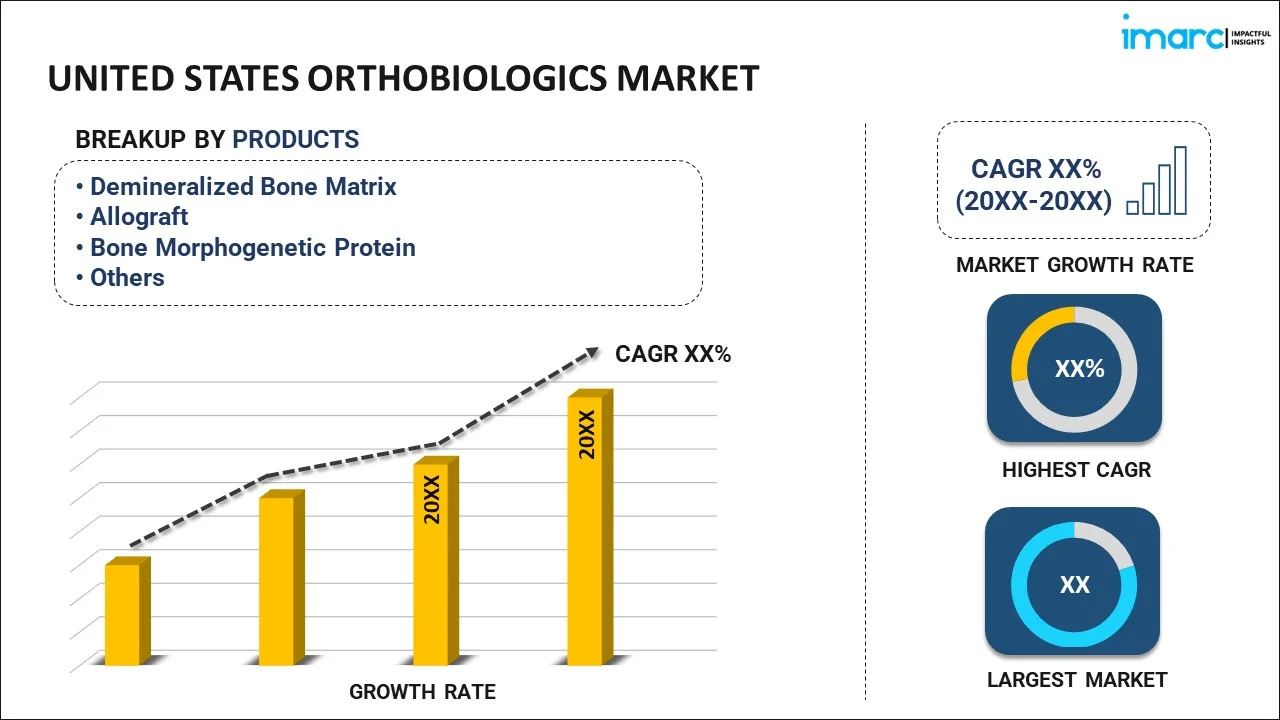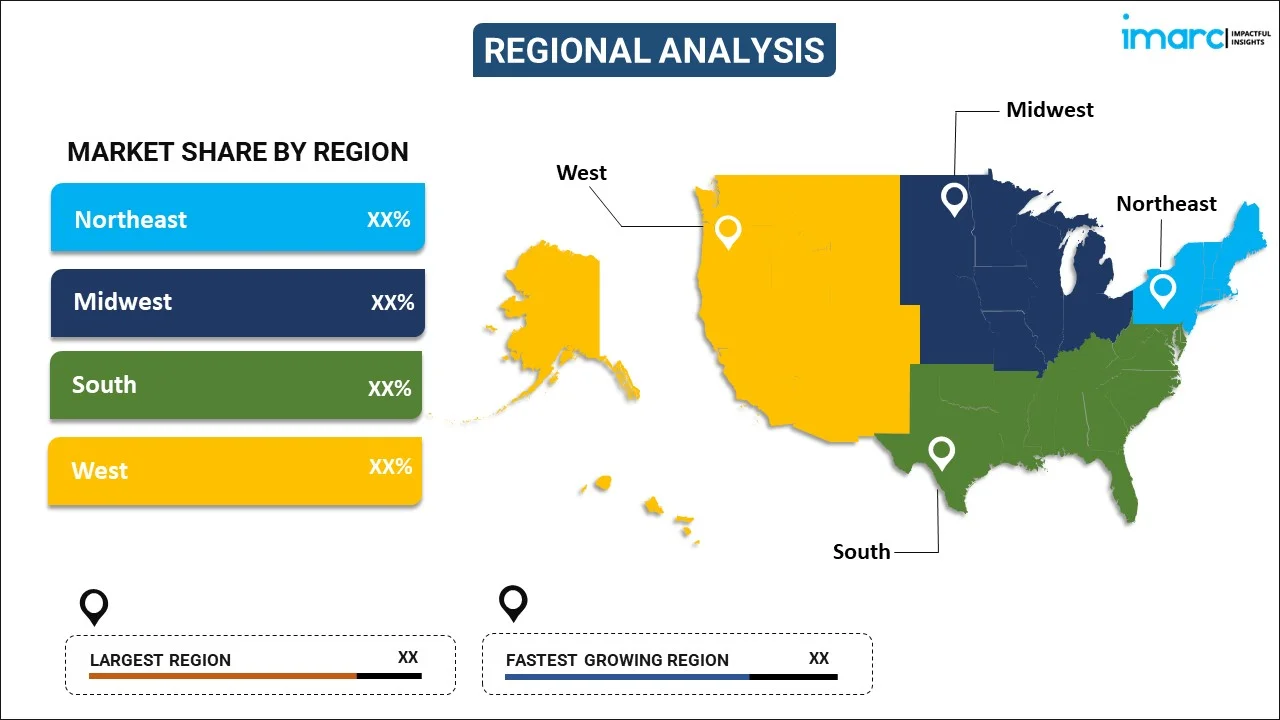
United States Orthobiologics Market Report by Product (Demineralized Bone Matrix, Allograft, Bone Morphogenetic Protein, Viscosupplementation Products, Synthetic Bone Substitutes, and Others), Type (Knee, Ankle, Hip, Wrist and Shoulder, Spine, and Others), Application (Osteoarthritis and Degenerative Arthritis, Spinal Fusion, Fracture Recovery, Soft Tissue Injuries, Maxillofacial and Dental Applications), End User (Hospitals and Ambulatory Centers, Research and Academic Institutes, Dental Clinics and Facilities, Orthopedic Clinics), and Region 2025-2033
Market Overview:
United States orthobiologics market size reached USD 1.5 Billion in 2024. Looking forward, IMARC Group expects the market to reach USD 2.0 Billion by 2033, exhibiting a growth rate (CAGR) of 3.5% during 2025-2033. The growing prevalence of orthopedic disorders, such as osteoarthritis, osteoporosis, and spinal disorders, rising development of more effective and targeted therapies, and increasing advancements in 3D printing, biomaterials, and stem cell research represent some of the key factors driving the market.
|
Report Attribute
|
Key Statistics
|
|---|---|
|
Base Year
|
2024 |
|
Forecast Years
|
2025-2033
|
|
Historical Years
|
2019-2024
|
| Market Size in 2024 | USD 1.5 Billion |
| Market Forecast in 2033 | USD 2.0 Billion |
| Market Growth Rate (2025-2033) | 3.5% |
Orthobiologics refers to a group of biological substances and therapies that harness the natural healing mechanisms of the body to treat musculoskeletal conditions and injuries. They are derived from naturally occurring materials in the human body, which include growth factors, stem cells, and platelet-rich plasma (PRP). They work by stimulating cell proliferation, tissue repair, and inflammation modulation through growth factors, cytokines, and other bioactive molecules. They provide non-surgical alternatives for treating musculoskeletal conditions, offering patients less invasive and potentially more effective solutions. They have the potential to accelerate healing, reduce pain, and improve overall patient outcomes in orthopedic and sports medicine. They can effectively alleviate pain associated with conditions like osteoarthritis. They enhance joint function and overall mobility by promoting tissue regeneration. They also help patients to reduce their reliance on pain medications or anti-inflammatory drugs. They are employed to accelerate the healing of damaged tendons and ligaments, often seen in conditions like rotator cuff injuries and Achilles tendonitis.
United States Orthobiologics Market Trends:
At present, the rising prevalence of orthopedic disorders, such as osteoarthritis, osteoporosis, and spinal disorders, especially among the geriatric population, represents one of the key factors impelling the market growth in the United States. Additionally, increasing advancements in 3D printing, biomaterials, and stem cell research are enabling more efficient and effective treatments. The ongoing research and development (R&D) in cellular and molecular biotechnologies are enhancing the efficacy of orthobiologic products, thereby driving their adoption. Besides this, the growing preference for minimally invasive (MI) treatment options among patients and healthcare providers is encouraging the utilization of orthobiologics. These procedures generally offer quicker recovery times, lower risk of complications, and are less painful compared to traditional open surgeries. Moreover, the rising awareness about the benefits of orthobiologics, supported by online platforms and social media, which play a significant role in educating patients and shaping their treatment, is facilitating the market growth in the country. In addition, the increasing development of more effective and targeted orthobiologic therapies, reducing the one-size-fits-all approach, and enhancing patient outcomes are propelling the market growth. Furthermore, the growing integration of artificial intelligence (AI) and machine learning (ML) in the orthobiologics to analyze clinical data, predict treatment outcomes, and aid in the design of new biologic materials and therapies is positively influencing the market. Apart from this, the rising integration of telemedicine into orthobiologic consultations and follow-ups is making it easier for patients to access care, especially those in remote or underserved areas.
United States Orthobiologics Market Segmentation:
IMARC Group provides an analysis of the key trends in each segment of the market, along with forecasts at the country level for 2025-2033. Our report has categorized the market based on product, type, application, and end user.
Product Insights:

- Demineralized Bone Matrix
- Allograft
- Bone Morphogenetic Protein
- Viscosupplementation Products
- Synthetic Bone Substitutes
- Others
The report has provided a detailed breakup and analysis of the market based on the product. This includes demineralized bone matrix, allograft, bone morphogenetic protein, viscosupplementation products, synthetic bone substitutes, and others.
Type Insights:
- Knee
- Ankle
- Hip
- Wrist and Shoulder
- Spine
- Others
A detailed breakup and analysis of the market based on type have also been provided in the report. This includes knee, ankle, hip, wrist and shoulder, spine, and others.
Application Insights:
- Osteoarthritis and Degenerative Arthritis
- Spinal Fusion
- Fracture Recovery
- Soft Tissue Injuries
- Maxillofacial and Dental Applications
The report has provided a detailed breakup and analysis of the market based on the application. This includes osteoarthritis and degenerative arthritis, spinal fusion, fracture recovery, soft tissue injuries, and maxillofacial and dental applications.
End User Insights:
- Hospitals and Ambulatory Centers
- Research and Academic Institutes
- Dental Clinics and Facilities
- Orthopedic Clinics
A detailed breakup and analysis of the market based on end user have also been provided in the report. This includes hospitals and ambulatory centers, research and academic institutes, dental clinics and facilities, and orthopedic clinics.
Regional Insights:

- Northeast
- Midwest
- South
- West
The report has also provided a comprehensive analysis of all the major regional markets, which include the Northeast, Midwest, South, and West.
Competitive Landscape:
The market research report has also provided a comprehensive analysis of the competitive landscape in the market. Competitive analysis such as market structure, key player positioning, top winning strategies, competitive dashboard, and company evaluation quadrant has been covered in the report. Also, detailed profiles of all major companies have been provided.
United States Orthobiologics Market Report Coverage:
| Report Features | Details |
|---|---|
| Base Year of the Analysis | 2024 |
| Historical Period | 2019-2024 |
| Forecast Period | 2025-2033 |
| Units | Billion USD |
| Scope of the Report | Exploration of Historical Trends and Market Outlook, Industry Catalysts and Challenges, Segment-Wise Historical and Future Market Assessment:
|
| Products Covered | Demineralized Bone Matrix, Allograft, Bone Morphogenetic Protein, Viscosupplementation Products, Synthetic Bone Substitutes, Others |
| Types Covered | Knee, Ankle, Hip, Wrist and Shoulder, Spine, Others |
| Applications Covered | Osteoarthritis and Degenerative Arthritis, Spinal Fusion, Fracture Recovery, Soft Tissue Injuries, Maxillofacial and Dental Applications |
| End Users Covered | Hospitals and Ambulatory Centers, Research and Academic Institutes, Dental Clinics and Facilities, Orthopedic Clinics |
| Regions Covered | Northeast, Midwest, South, West |
| Customization Scope | 10% Free Customization |
| Post-Sale Analyst Support | 10-12 Weeks |
| Delivery Format | PDF and Excel through Email (We can also provide the editable version of the report in PPT/Word format on special request) |
Key Questions Answered in This Report:
- How has the United States orthobiologics market performed so far and how will it perform in the coming years?
- What has been the impact of COVID-19 on the United States orthobiologics market?
- What is the breakup of the United States orthobiologics market on the basis of product?
- What is the breakup of the United States orthobiologics market on the basis of type?
- What is the breakup of the United States orthobiologics market on the basis of application?
- What is the breakup of the United States orthobiologics market on the basis of end user?
- What are the various stages in the value chain of the United States orthobiologics market?
- What are the key driving factors and challenges in the United States orthobiologics?
- What is the structure of the United States orthobiologics market and who are the key players?
- What is the degree of competition in the United States orthobiologics market?
Key Benefits for Stakeholders:
- IMARC’s industry report offers a comprehensive quantitative analysis of various market segments, historical and current market trends, market forecasts, and dynamics of the United States orthobiologics market from 2019-2033.
- The research report provides the latest information on the market drivers, challenges, and opportunities in the United States orthobiologics market.
- Porter's five forces analysis assist stakeholders in assessing the impact of new entrants, competitive rivalry, supplier power, buyer power, and the threat of substitution. It helps stakeholders to analyze the level of competition within the United States orthobiologics industry and its attractiveness.
- A competitive landscape allows stakeholders to understand their competitive environment and provides an insight into the current positions of key players in the market.
Need more help?
- Speak to our experienced analysts for insights on the current market scenarios.
- Include additional segments and countries to customize the report as per your requirement.
- Gain an unparalleled competitive advantage in your domain by understanding how to utilize the report and positively impacting your operations and revenue.
- For further assistance, please connect with our analysts.
 Inquire Before Buying
Inquire Before Buying
 Speak to an Analyst
Speak to an Analyst
 Request Brochure
Request Brochure
 Request Customization
Request Customization




.webp)




.webp)












